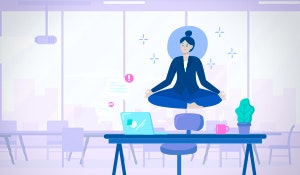2020 was a terrifying year for everybody everywhere. Even after two years, businesses are dealing with the aftermath of the pandemic. While there were rapid shifts from remote to hybrid work, employee wellbeing and wellness programs took centre stage in every workplace. Different organisations have rolled out these initiatives to support their workforce at different levels.
Two subject-matter experts joined us at our Parichay Webinar Series to discuss the importance of employee wellbeing and how it has been impacting organisations.
The speakers, Sanjeeb Lahiri, CHRO (GRP Ltd) and Ayatakshee S, Asst. Professor (Dept. of Psychology, CHRIST Bangalore) also cleared many myths and answered thought-provoking questions.
Here are the edited excerpts from the conversation.
What is the difference between employee wellness and employee wellbeing?
Wellness is restricted to the physical and mental aspects of health. But wellbeing is holistic in nature. It is a combination of physical, emotional, psychological, social and other aspects.
Why is it important for HR professionals to understand the difference between wellness and wellbeing?
When an organisation designs a program or frames a set of policies focused only on wellness, it is restricted to the physical and mental aspects of health. So, they need to be mindful before proceeding without looking at the scenario holistically.
What are the various aspects of wellbeing organisations need to consider?
Physical, social, emotional, intellectual, spiritual, occupational and environmental wellbeing are the different aspects of wellbeing.
It is not enough for an organisation to only educate the employees on the wellbeing or wellness programs. It also becomes important for the employees to take some action towards it.
Ayatakshee S, Asst. Professor (Dept. of Psychology, CHRIST Bangalore)
How is employee wellness linked to employee performance and productivity?
Wellness programs are likely to curtail absenteeism due to illness. As a result, it reduces insurance claims and costs. If an employee feels holistically healthy, the motivation and satisfaction levels will be on the higher side. Furthermore, when employees see what their organisation is doing for them, they would want to reciprocate the gesture by improving their own productivity and performance.
How can we integrate wellbeing into the design of work so that it can strengthen organisational performance?
If a wellness program is not integrated into work, the employees will look at it as just another HR program. Also, the employer must aim to reduce the readiness gap by making employees understand the importance of wellbeing programs. This urges them to take action. It is also important to know how to measure the ROI of the program.
How can collaboration and teamwork promote the mental wellbeing of employees?
Social isolation adversely affects the employee's mental, physical and emotional health. Team collaboration enhances the employees' wellbeing by improving their communication and trust in their colleagues and workplace.
How can burnout affect employee wellbeing, and what can organisations do to prevent it?
Burnout is a state where individuals feel that they don't have the energy. It is also not something that happens on one particular day; it is a long process. However, organisations must first identify smaller symptoms like sickness, tiredness, dip in performance, etc. They should also open communication channels that allow people to seek help without fear of discrimination or backlash.
How important is it to have a dedicated team to spearhead the employee wellbeing initiatives of an organisation?
A dedicated team is likely to be more committed. They can give their 100% to the wellbeing program. Also, it's easier for them to understand and follow the processes of the organisation. But it is advisable to have a new team every year. This brings a new perspective to help address newer challenges.
What are the key attributes to consider when choosing a digital tool to enhance an employee wellness program?
Data security is extremely important in the current context since external eyes and ears are monitoring these tools. The next important aspect is reporting. The user should ask these questions: What is the tool telling me? How is it telling me? How collaborative is it? Is it easy to use? Does it provide information without infringing any laws?
Thankfully, all of these platforms are legally compliant. Some amount of data is extremely personal…
Sanjeeb Lahiri, CHRO (GRP Ltd)
Although cost is one of the factors, the organisation should know and decide what it wants to achieve with the new tool. Only then is the investment justified.
Some organisations think their work is done when they offer a gym pass to their employees or send them to a counsellor. Employee wellbeing is a lot more than that. Don’t you think so? Let us know your thoughts in the Comments section.
Watch the recording of the entire webinar









